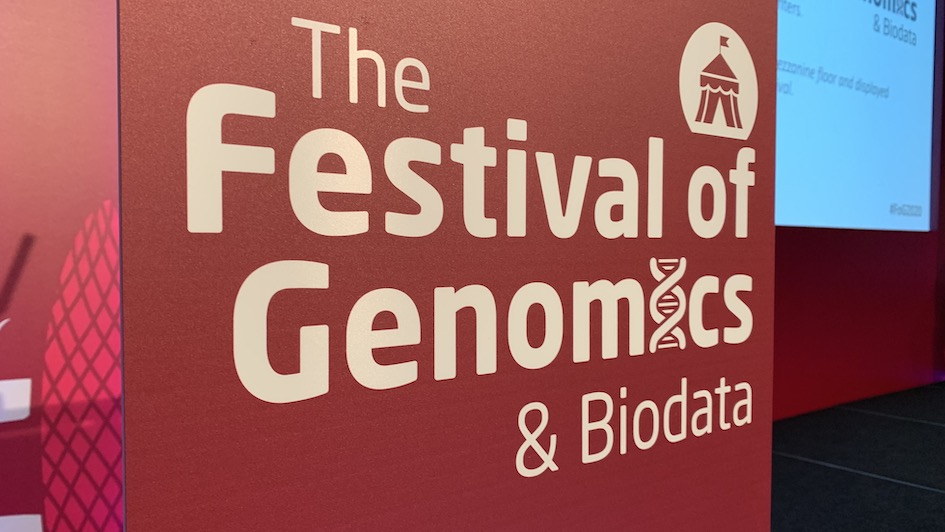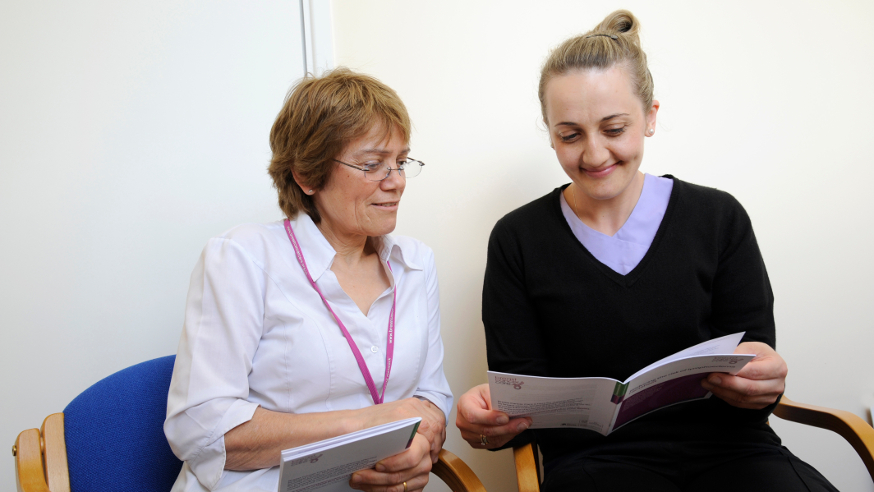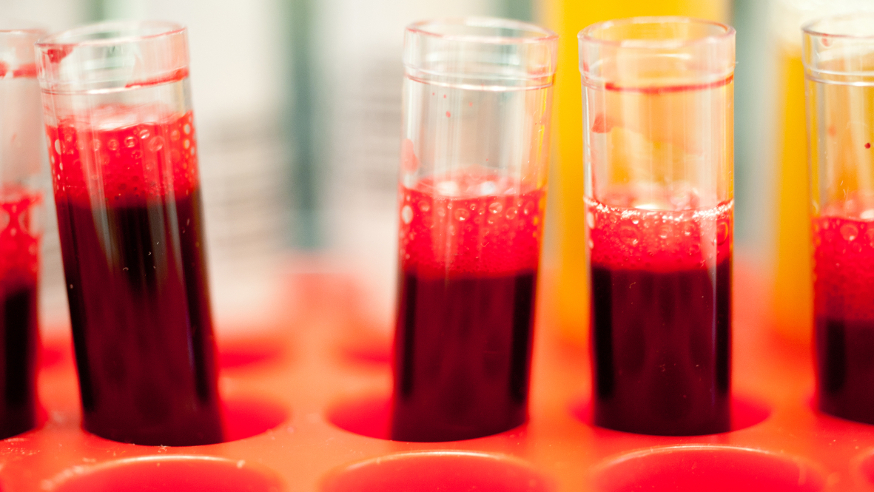
Back in-person for the first time in three years, the 8th annual Festival of Genomics and Biodata turned the Business Design Centre in Angel, London into a hub of discussion. The rapidly evolving field of genomics and biodata has seen numerous advances in recent years – here are seven lessons we learned at this year’s festival:
1. Genome sequencing is now way ahead of drug discovery and only innovative ways of working will help us catch up
According to Professor Paul Workman, keynote speaker at the conference, genome sequencing has outpaced drug discovery.
“We’re now in a very interesting phase where the sequencing of genomes is way ahead of drug discovery,” warned Professor Paul Workman, Harrap Professor of Pharmacology and Therapeutics a the ICR. “We're at an inflection point where the sequencing is now so fast, so complete and relatively inexpensive that we have many unexplored drug targets and biomarkers at our fingertips, but drug discovery is still taking up to 20 years to get from an idea to an approved drug.”
In his keynote presentation at the Festival of Genomics, Professor Workman spoke about some of the successes and challenges of drug discovery and how his team at the ICR are using innovative, creative methods to accelerate discovery of drugs that can even hit targets previously deemed “undruggable”– thus “expanding the druggable genome” as he describes it and treating cancer in completely new ways.
As an example, Paul showcased the AKT inhibitor capivasertib, which was recently shown to extend progression-free survival in advanced ER+ breast cancer patients in a major phase III clinical trial. The rapid discovery of capivasertib was underpinned by key basic structural biology research at ICR which enabled rapid fragment-based drug design in partnership with Astex Therapeutics.
Another ICR-discovered drug he discussed has recently entered phase I trial and has shown promise in animal models for some patients with ovarian cancers that are resistant to chemotherapy. It works by indirectly targeting HSF1, a transcription factor, or master switch that controls activity of genes within cells.
“HSF1 is an important target for treating cancer, but has long been considered undruggable,” explains Paul, “It has no suitable cavities or grooves to build a drug into. If we were going to stop HSF1 triggering cancer-causing messages that support tumour growth, then we had to think about targeting something else in the gene activation pathway, rather than HSF1 itself. The challenge was where to target?”
The team used an approach known as ‘phenotypic cell-based screening’. Rather than following the currently fashionable approach to drug discovery – starting with the molecular target and designing a small-molecule that can drug it, as with capivasertib – Paul’s team started by screening for chemicals that switch off the HSF1-mediated gene activation pathway and worked backwards to find the precise molecular mechanism of action .
“We built an analysis approach that showed us how effective the pathway is working in cells and whether HSF1 is switched on – simply put, when HSF1 was active the cells stained red, and when we find a compound that blocks the HSF1-regulated gene activation pathway, the redness is reduced. You don’t know exactly how the compound is working, but you can find out later.”
By screening hundreds of thousands of chemicals, Paul’s team found that such a small-molecule, and optimised it by medicinal chemistry into the final drug candidate – now called NXP800. Paul says, “We are excited about the successful blockade of HSF1-mediated gene activation and the resulting strong anticancer activity we see in animal models of drug-resistant ovarian and endometrioid cancer.” In years since the team have worked backwards to understand the finer details of how the drug works, which are still being untangled.
These two examples show how drug discovery can be sped up using innovative and creative technical approaches, and even make it possible to ‘drug the undruggable’.
2. Spotting which mutations in a tumour are inherited is key to improving cancer care
Tumour profiling is becoming more and more common. With a small tumour sample, sequencing can tell us which mutations are driving someone’s cancer and give us clues about which drugs might work for each patient.
But according to Professor Clare Turnbull, Professor of Translational Cancer Genetics at the ICR, tumour sequencing doesn’t tell us where the mutations came from, and this is also incredibly important for informing patient care.
Professor Turnbull spoke about her work as part of The European Society of Medical Oncology (ESMO) Precision Medicine Working Group, to develop recommendations for deciding which patients need follow up testing to determine if mutations found in their tumours developed with the cancer, or if they have been present since a patient was born and are present in all of a patient’s cells – also called germline mutations.
Knowing which mutations are germline has important implications for patient care. If a patient has a germline mutation, they may be at greater risk of developing cancer elsewhere in the body and they may have family members who carry the same gene mutation. They could therefore benefit from genetic counselling, more regular screening, preventative surgery and/or genetic tests for family members.
“Through new guidelines, we’ve created straightforward analytical strategy by which to select patients for whom follow-up testing to detect germline mutations is most productive. In this way, we can tailor their treatment and they can receive genetic counselling and potentially family-wide genetic screening.”

3. Streamlining genetic testing and counselling may help more women receive a lifesaving test for a BRCA gene fault
Grace Kavanaugh, Research Genetic Counsellor from the ICR, presented a Cancer Research UK-funded study called BRCA-DIRECT. The project takes a digital approach to speeding up and expanding access to genetic testing for breast cancer susceptibility genes BRCA1,BRCA2, and PALB2.
Around five per cent of all breast cancer cases are linked to an inherited gene fault in BRCA1 or BRCA2, and spotting patients who have these germline faults is key to ensuring patients get the appropriate treatment and follow up.
But getting a test is not always easy – it takes considerable time and effort for clinicians to assess if patients meet testing eligibility criteria and then provide patients with test information.
This can be a burden in an already challenging environment for the NHS.
BRCA-DIRECT instead takes patients through an online educational programme, so that they understand the implications of genetic testing before they can opt in or out. Patients have access to a genetic counsellor hotline to discuss any individual questions at any time.
The study will compare satisfaction and anxiety between patients who took the online learning module and those who received standard telephone counselling to determine if replacing initial counselling is satisfactory to patients.
And the pilot results are promising – patients in both groups reported similar levels of satisfaction. In fact, most patients stated they would opt for the digital process if given the choice in the future, with many people reporting that they felt they could take their time and take in the information at their own pace.
BRCA-DIRECT included more than a thousand patients, and the study team are now formally analysing outcomes from this cohort
BRCA-DIRECT will be expanding into more centres in the North Thames region later in 2023 through an implementation project– freeing up services so more people with cancer can receive genetic testing.
“We have limited resources for genetic testing and the bottleneck becomes feeding people through these eligibility criteria and generic information-giving appointments. By automating the process, while maintaining access to genetic counsellors through the hotline, we can speed up access to testing and help to free up key NHS resources.”
4. Access to genomic testing must be consistent and equitable
At the main stage of the conference, Professor Mike Hubank talked about how genomic testing is revolutionising cancer care.
As he explained, cancer is a disease of genetic changes – and understanding these changes can lead to a better, more tailored, 'personalised' diagnosis and treatment approach, as Professor Clare Turnbull also touched on. By using genomic tests, researchers can look at a patient's DNA to understand the cause of their disease and how to treat it.
As well as Scientific Director or Clinical Genomics at The Royal Marsden and Professor in Translational Genomics at the ICR, Professor Hubank is also Scientific Director of the North Thames Genomic laboratory hub. One of his goals is to make the most advanced clinical diagnostic methods available to all cancer patients.
Professor Hubank stressed that diagnostic genomic testing is not as expensive as it used to be, and, importantly, that it must be delivered in an equitable manner. As he said, we must ensure genomic testing becomes available to everyone, not just a few ‘elite’ hospitals.
“If we’re going to deliver the benefit of genomics to cancer patients, it has to be all cancer patients,” said Professor Hubank.
Fortunately, when it comes to cancer care, some genomic approaches are already being used in the NHS to help provide insights into the causes of the disease and to hopefully change the way some cancers are diagnosed and treated.
Professor Hubank also touched on a central feature of the NHS Genomic Medicine Service (GMS) - the National Genomic Test Directory, which outlines the full range of genomic tests that are commissioned for the NHS in England. This test directory is updated regularly and aims to provide consistent and equitable access to genomic testing.
By identifying specific genetic changes linked to different cancers, these tests can help diagnose the disease more accurately, determine the best treatment or even predict the risk of developing cancer or seeing it return.
To bring his talk to a close, Professor Hubank stressed the importance of research in advancing genomic testing: “Research and diagnostics are the same thing. All the data and research feeds back into the clinical loop.”

5. While liquid biopsies are hugely promising, there are also challenges to address
Also, at the main stage of the Festival of Genomics, the ICR’s Professor Janet Shipley joined a panel of experts to discuss the value of using liquid biopsies for early cancer detection, screening, and treatment monitoring in cancer care.
Some of Professor Shipley’s recent work has focused on studying these blood test liquid biopsies to find out if they could help guide the treatment of children with rhabdomyosarcoma.
Liquid biopsies of various types provide many benefits to patients, which is why they need to be robustly tested and validated in clinical trials in order to justify their use routinely in the clinic. They are less invasive than traditional tissue biopsies, allowing scientists and clinicians to discover a wide range of information about individual cancers and their responses to treatment through a simple blood sample.
However, the panel also discussed some considerations and challenges that must be tackled as liquid biopsies enter the clinic – false positives, false negatives and misleading reassurance of remission or cure if a liquid biopsy is negative.
As the experts discussed, liquid biopsies are being used more and more when it comes to diagnostics and treatment selection where clinical benefit has been demonstrated. When it comes to screening in asymptomatic populations, the situation is much less advanced.
One of the examples of progress in this setting is the NHS-Galleri trial, which aims to detect early-stage cancers through a simple blood test. This trial has already been launched and it involves 165,000 people.
Research on patients at high-risk or with signs of cancer has already found that the test, which checks for molecular changes, can identify many types that are otherwise difficult to detect and diagnose early.
While this is exciting, experts cautioned about false reassurance from a negative test. “Just because you have a negative liquid biopsy, it doesn’t mean you have no cancer”, they said. “People need to understand it’s not the be all and end all. It’s a conversation about risk – it’s not a yes or no.”
They recommended that while trialling liquid biopsies in this way, it must be made very clear to patients that people still need to go for standard screening appointments, even if their liquid biopsy was negative.
6. Understanding cancer ‘heterogeneity’ is the key to improving outcomes for breast cancer
Heterogeneity is a word that cancer researchers use very often. It essentially means variation. For example, the term can be used to describe the differences between the same cancer type in different patients (e.g., hormone-positive or hormone-negative breast cancer) or the differences between cancer cells within a single tumour.
In her talk, which touched on the importance of untangling heterogeneity in breast cancer, Dr Rachael Natrajan explained that, despite new treatment advances, advanced breast cancer is still an incurable disease and a major cause of cancer deaths.
This is partly because the way a tumour's genetic makeup varies within itself and how it affects the area around it – how it interacts with its ‘ecosystem’ – both play a role in determining how well the cancer will respond to treatment.
In other words, heterogeneity – or differences within a tumour – leads to differences in how well a tumour will respond to different treatments.
Dr Natrajan described how her lab, in the Breast Cancer Now Toby Robins Research Centre at the ICR, is working to find new genetic changes driving differences within cancer cells.
Her team uses advanced techniques like single cell profiling approaches, which examine the characteristics of individual cells, together with functional-genomic screens, which examine how changes in a cell's genes affect its behaviour and function. Using these techniques, her group seeks to understand how sub-clonal heterogeneity affects breast cancer. By finding drivers for specific subtypes of breast cancer, they can then work on targeting these drivers and exploiting cancer cells’ weaknesses.
Some of Dr Natrajan’s research has already pinpointed changes in some triple negative breast cancers that make them vulnerable to targeted treatments.
For instance, her team found that triple negative breast cancer cells with low levels of a protein called CREBBP are more aggressive and rely on the CDK4 and CDK6 proteins. This is important because it means existing drugs that block CDK4 and CDK6, such as palbociclib, could be an effective treatment.
7. Genomics in cancer evolution is about a whole lot more than DNA mutations
DNA mutations are a hallmark of cancer. Their accumulation causes cancer to develop and enable cancers to adapt and evolve to become resistant to new treatments. But there are other levels, outside of DNA mutations, that drive cancer, or allow it to change its behaviour.
Professor Trevor Graham is Director of the Centre for Evolution and Cancer at the ICR. In his presentation he spoke about ‘multi-omics,’ and how his team look at cancer genomes on every level to understand what is driving cancer and controlling cancer evolution.
“Patterns of DNA mutations within tumours are a lot like tree rings – it’s a secret diary written into the genomes of cancer cells, and it can tell us a lot about a cancer’s past, the forces that shaped it, and what is currently driving it."
They use whole genome studies to look for recurrent mutations to better understand which mutations are driving a cancer. But they’ve also developed entirely new ways to track cancer evolution on other levels.
Professor Trevor Graham also spoke about two papers from his group, published simultaneously in Nature last year, which looked at epigenetic control of cancer evolution and something called phenotypic plasticity, which allows cancer cells to change in response to their environment.
Epigenetics involves chemical changes to the three-dimensional structure of DNA which don’t alter the DNA code itself but can control access to genes.
Professor Graham explained how his team tracked the influence of epigenetics on the evolution of bowel cancers, separately to other layers of control. They found that these epigenetic changes were common in cancer cells and occurred near genes already known to drive cancer. They also showed that the epigenetic changes can be inherited, meaning they can contribute to how cancer evolves.
Their other paper looked at why cancer cells within the same tumour can be so different to one another – a characteristic that helps some cells develop survival advantages and become resistant to cancer treatments. They found that a lot of changes to DNA code didn’t lead to changes in gene activity, so did not explain the variation. This suggests other factors are at play.
Their work tells us that fully understanding how cancer evolves requires more than one lens and that there are exciting opportunities to create cancer treatments which not only target DNA mutations but also other levels of cancer control.
Find out more about how we are using genomics technologies in cancer research at the ICR.
Find out more about our genomics research
comments powered by